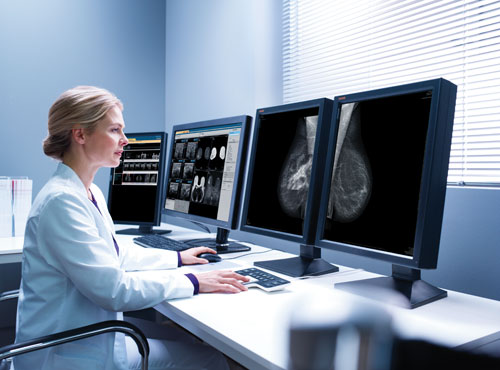
Photo courtesy of Philips Healthcare
With all the conflicting information surrounding screening mammography, it is hard for breast radiologists not to be just as confused as the patients and referring clinicians. As a breast radiologist, I am passionate about breast imaging and the patients I serve.
If you feel the same way as I do about your work and patients, you too must struggle with the newest set of guidelines put forth by the United States Preventive Services Task Force (USPSTF). These recommendations have alarmed, frustrated and confused not only myself, but also many of my colleagues in the field. The USPSTF guidelines recommend screening mammography begin at age 50 for average risk women and then biennial after that, up to age 74. Now, patients age 40-49 can discuss the option of screening with their providers and the decision to start screening will essentially be left up to them. Most, if not all, of these recommendations by the USPSTF have been scientifically refuted, yet the news outlets inundate the medical professionals and, even worse, the general population with these erroneous conclusions.
Muddy Water
Those of us in the trenches every day know from our own experiences that screening mammography saves lives. We see first-hand how a breast cancer diagnosis, or lack thereof, affects the patient and their loved ones. We also know how difficult it is to keep patients compliant with screening recommendations, especially those patients with lower income. When the Affordable Care Act (ACA) was implemented, there was renewed hope we would be able to treat an underserved segment of the population, including those with lower or limited incomes and African American women, who have a 42 percent higher rate of death from breast cancer than Caucasian women. However, with the latest USPSTF recommendations released, it is highly unlikely the ACA will require coverage for these individuals.
It is well-known that the arguments for and against screening mammography have been ongoing for years, but the newest recommendations have muddied the water even more. With no clear guidelines, how do breast radiologists address the questions from the referring physicians? From their own patients? As experts in our communities, it is our task to assist and guide the conversations between the referring clinicians and their patients regarding screening mammography recommendations.
The best one can do for their profession, for their colleagues and for their patients is become educated on the facts of this controversy. There are many resources available to educate yourself: Form a defensible platform, engage your peers and get involved with the American College of Radiology (ACR), other national societies and local medical groups. Educate others. Search out opportunities in your community to educate clinicians and patients regarding the value of screening mammography.
Here are a few facts I find helpful to guide the conversations:
• Breast cancer is the most common non-skin related cancer among American women;
• Breast cancer is the second most common cause of death among American women of all ages;
• Mammography is the only screening tool proven to reduce death from breast cancer. Randomized controlled trials have demonstrated this reduction when screening began at age 40;
• Approximately 250,000 new breast cancer diagnoses are expected in 2016;
• Approximately 40,000 deaths are expected from breast cancer in 2016;
• The incidence of breast cancer increases with age;
• The rate of death from breast cancer is reduced by 30 percent for patients who are regularly screened by mammography;
• 21 percent of patients diagnosed with invasive cancers are ages 40-49;
• Risk-based screening is not valid. Seventy-five percent of patients diagnosed with invasive cancer are not considered high-risk. Typically the only risk factor is their gender;
• Radiation harm is negligible. The amount of radiation of 100 mammograms is equal to radiation received from one computed tomography (CT) scan. Moreover, the amount of radiation received from one mammogram is similar to the amount of radiation received during a cross-Atlantic flight;
• Approximately 50 percent of women screened annually for 10 years will experience a false positive. However, patient education can mitigate the transient anxiety experienced by patients. A study has shown that patients are willing to accept this “harm” as long as a life is saved; and
• Defining “over diagnosis:” Some diagnoses may be treated even though they may never be life threatening. However, there is no scientific data available to indicate when to treat and when not to treat. itn
Carrie Horst, D.O., is board certified in radiology. She completed her fellowship in breast imaging at the Mount Sinai Medical Center and is a member of the American College of Radiology and the Society of Breast Imaging. She now serves as the medical director and director of breast imaging at the Diagnostic Center for Women.


 December 17, 2025
December 17, 2025 









